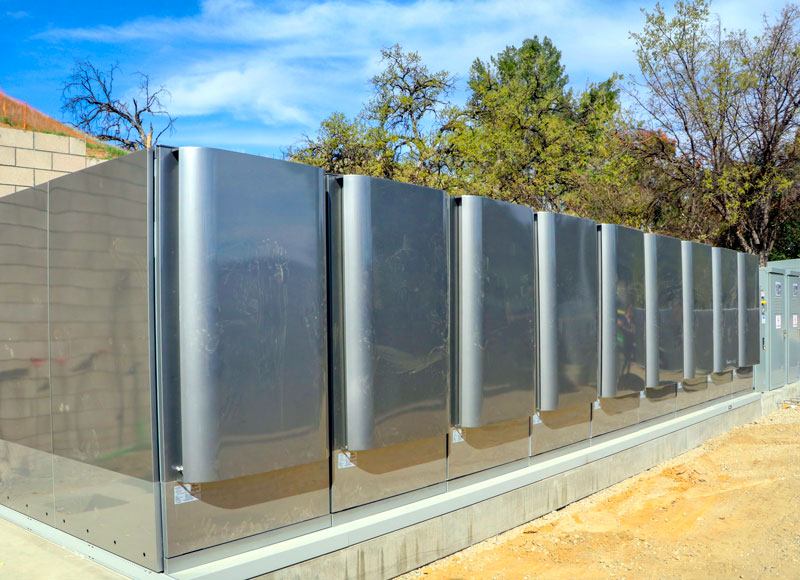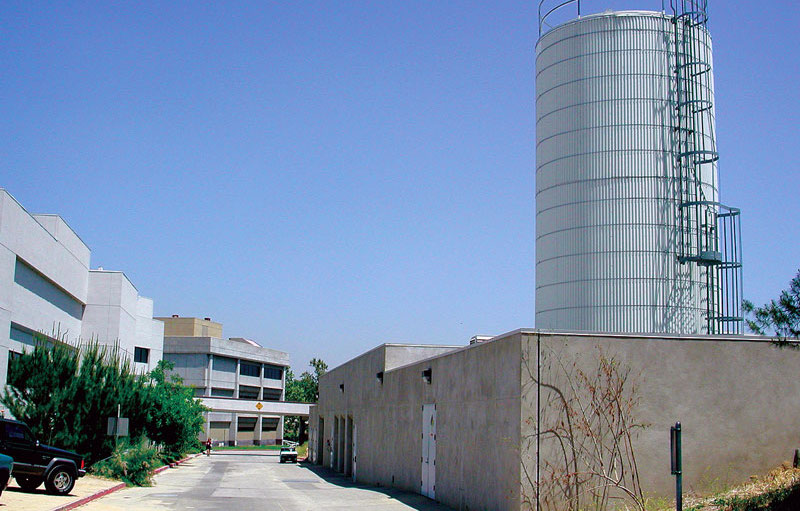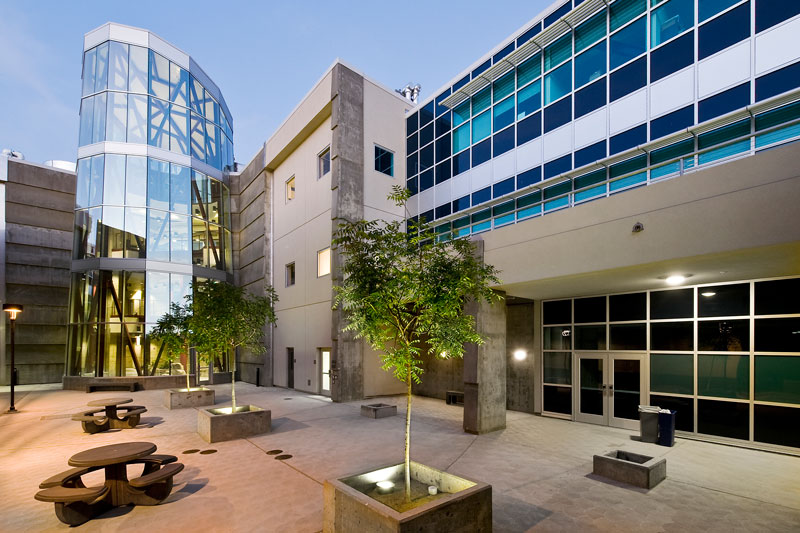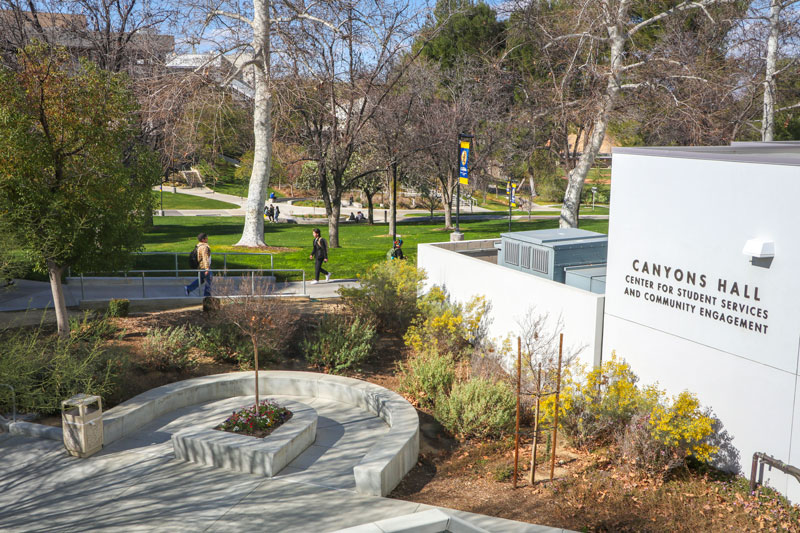Sustainability
College of the Canyons has a long history of embracing sustainable technologies that are friendly to the environment, as well as cost- and energy-efficient.

Bank of fuel cells, Valencia campus
Fuel Cells
A fuel cell/battery storage plant with 1.5 megawatts of capacity increases our overall on-site power generation to 70 percent, significantly reducing the college's dependence on the power grid and bringing the college one step closer to energy independence. The plant also has enough reserve capacity to power the entire campus. Funded by a $3 million award from the South Coast Air Quality Management District (SCAQMD), the plant went online in 2020.

South Plant, Valencia campus
Central Plants
A central plant is a facility housing chillers, boilers and cooling towers. It serves as a single source of hot water (heating both air and potable water) and chilled water (for cooling air) that supplies multiple buildings from a central location, all controlled by a sophisticated computer system that continually and automatically adjusts its controls to provide the highest possible levels of energy efficiency. Most new buildings provide heating, cooling and hot water sufficient to supply just that building and allow individual control of the systems. This is a tremendous waste of natural resources, as the efficiency of a per-building approach is much less than a single, larger facility that can serve several buildings simultaneously. When a campus becomes a conglomeration of numerous and varied buildings encompassing hundreds of thousands of square feet, the combined inefficiencies and waste of separate systems is enormous. This has never been the case at College of the Canyons.
College of the Canyons actually began life with a central plant concept. The first such installation was, and still is, on the roof of Bonelli Hall. It serves the Laboratory (Boykin Hall), Instructional (Bonelli Hall) and Classroom (Seco Hall) buildings. As the campus began its expansion in the early 1990s, Superintendent-President Dr. Dianne Van Hook began applying for funds for the first major central plant, the South Plant, located just east of Mentry Hall. Even though the idea was unpopular with the state, and the Department of Finance saw no benefit in funding such a project, Van Hook obtained the money to build the first genuine central plant in the California community college system.
The college completed a remodeling of the Bonelli Hall plant, a remodeling and expansion of the South Plant, and added the North Plant. Together, these three plants serve all buildings on the campus - and they boast enough reserve capacity for the buildout of this college. As a leader in the community college system, College of the Canyons also has added cogeneration to the North and South Plants. Cogeneration is a process in which electrical power is created via natural gas-fired generators. The waste heat from the exhaust is used to produce both hot and cold water for normal central plant functions. This not only allows the college to cut power costs dramatically, it also reduces its reliance on the public energy grid. With the systems reaching an efficiency in the 90 percent range of every therm of natural gas used, the college is saving large amounts of natural resources and contributing significantly to the conservation of precious resources.
These projects are so efficient that the college has received substantial rebates - in the neighborhood of $1 million - from the power and gas utilities. The rebates were made possible by a program developed by the California community college system, which has been recognized by the American Council for an Energy-Efficient Economy for its "exemplary energy efficient program and for displaying national leadership in this area." College of the Canyons is proud to be one of the largest beneficiaries of the statewide program and to have been recognized where it counts - the pocketbook - by Southern California Gas and Southern California Edison for success in creating projects that will save, and continue saving for decades to come, our environment and natural resources.
Lighting
- Area Motion Sensors - These turn lights off automatically when no motion is detected and are installed in every room of the campus.
- Electronic Dimming - This is now part of the college's standard new-construction specifications.
- Efficient Lighting - The entire campus has been retrofitted with T-8 bulbs and electronic ballasts, saving more than 30 percent over conventional fluorescent systems. Metal halide and mercury vapor interior lights have been replaced with T-5 lamps and ballasts, which use about 25 percent of the power of the previous fixtures. All lighting on exterior walkways and in parking lots has been retrofitted with 70-watt fixtures and ballasts, down from the original 250-watt fixtures.
- Computer-Controlled Lighting - All exterior and some interior lighting are on a computer system that can be controlled externally to turn lights on and off at predetermined times, saving electricity, bulbs and the manpower to maintain and manually turn the lights on and off.
- Natural Lighting - The large expanses of glass on all new buildings reflects the college's efforts to reduce its dependency on manufactured light.

Hasley Hall tower, Valencia campus
Architectural Effects
Placing a building in the correct orientation of the sun's path is a simple and effective way of reducing the potential heat demand of that building on its cooling systems. Whenever possible, the college has put its largest glass "fronts" facing east or north, allowing the full benefit of natural lighting without the potential overload of the late afternoon sun. The Library, Pico Canyon Hall, the Performing Arts Center, and the Hasley Hall tower all share this concept and implementation. In addition, the college has employed overhangs and tinted glass, which is always the most efficient glass available, at the time of construction. What one won't find on the campus but on others with more moderate climes are operable windows, which are counterproductive in the Santa Clarita Valley.
Power Conservation
Together, these electricity-saving measures contribute significantly to reducing the college's overall energy consumption:
- Variable Frequency Drives - These electronic dimmers are for very large electrical motors used for pumping water and turning fans. These 30- to 75-horsepower motors consume massive amounts of energy if left to their own demand. But that is not allowed to happen; VFDs are installed in front of the motors to electronically "trick" them into believing that they're receiving their full charge. In reality, they are getting only a fraction of demand when loads are reduced. The results are substantial savings, generally saving the cost of the equipment in energy savings in less than a year.
- Power Conditioners - These filters provide, with no additional electrical demand, perfect-phased current to equipment, allowing the equipment to function at optimal design standards without having to compensate for fluctuations in the power stream. Seemingly infinitesimal, this step adds up to big savings in a short period of time when multiplied by the number of pieces of equipment.

Drought-tolerant landscaping, Valencia campus
Environmental Measures
- Landscaping - The entire irrigation system is computer-controlled, allowing minute adjustments with large savings of natural resources. We have instituted a native and drought-resistant plant scheme that dramatically reduces the need for massive amounts of water, survives the temperature swings of the area and looks better than typical mall-type landscaping that others use. The stadium grass was removed (saving water and grass clippings from maintenance) and was replaced with FieldTurf, an artificial grass and base composed of recycled tire and shoe rubber.
- Recycling - The college has complied with the California Integrated Waste Management Board's initiative of reducing solid waste generation by 50 percent. This has been achieved with an aggressive recycling program (paper, bottles and cans), landscape program (separation of green waste along with composting), electronic recycling (computers, toners and ink cartridges) and construction materials separation recycling (wood in one container, metal in another, drywall in another, etc.). Together, these steps have substantially reduced the college's output to landfills.
- Waterless Restroom Urinals - These waterless restroom urinals require no water and have helped the college conserve this precious resource. In fact, we were the first California community college to convert to 100 percent waterless urinals, saving hundreds of thousands of gallons of water annually.
In short, College of the Canyons has made substantial progress toward maximum sustainability, long before it became popular to do so. While other districts take great pride in publicizing their LEED (Leadership in Energy and Environmental Design) and "green" buildings, College of the Canyons believes other priorities take precedence. It takes a tremendous amount of money to certify and commission projects to the differing levels of sustainability, and the college would rather spend its finite dollars on serving the needs of its students. The college is more than pleased with its sustainability program and its results, more so than garnering attention for its efforts.

 My Canyons
My Canyons  Canvas
Canvas 
